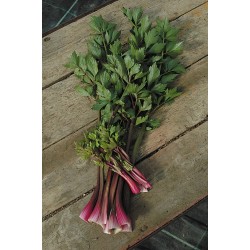



Celery Red Giant has excellent red stems and pink hearts. An old variety, good cold resistance. The whole plant is edible including the leaves not just the stem. Good for early production, if sown under protection inside. Red Giant is a very reliable trench celery. Keeps for a long time in a cool area or in the fridge.
As a close relative of celery, celeriac is grown under similar conditions. The flavor and appearance of the related plants is quite different, however. While celery is grown for its above-ground stalks, celeriac is grown for its below-ground bulb.
The celeriac bulb looks much like a turnip and develops at soil level like a turnip does too, but the flavor is not the same. The top leaves of the plant can also be used as a flavor enhancer for soups and stews, much like the leaves from atop stalks of celery.
Celery is a cool season vegetable that requires a long growing season to get it from seeds to table. Allow 120 days for most varieties of celery to mature and it’s best to time the planting of the vegetable so it will ripen when the weather has cooled down in the fall. Use these tips and grow your own celery from seeds.
Celery grows best in full sun, but the plant will tolerate light afternoon shade. This vegetable is a heavy feeder and will need well-draining soil that is rich in organic matter to grow in.
Till the soil to 10-12 inches deep, then work in at least 6 inches of compost or well-rotted cow manure to provide the soil drainage and food supply celeriac demands for optimum growth.
Some of the stem vegetables take long to germinate; keep these vegetable seeds in the house, vegetable seeds germinate better in warm places; on a warm windowsill, or in the airing cupboard. Start seeds indoors 8-10 weeks prior to the last predicted frost date in spring. Place a good quality potting soil in a container(s) that are 4-6 inches deep. Cover the containers with lightweight seed cloth or burlap to help keep the soil moist at all times. Remove cloth after seeds have germinated. Thin plants to two inches apart after they reach two inches tall. Keep seedlings in a warm, bright location and water regularly so the soil does not dry out.
If sowing celery seeds directly into garden soil, cover area with seed cloth or burlap until seeds germinate. Keep cloth and soil moist.
When the celery seedlings are 4 inches tall and all danger of frost has past, they can be transplanted into prepared garden soil.
Create 4 inch deep trenches in the garden soil and space them 2 feet apart. Set the celeriac seedlings in the trenches 8 inches apart. Gently pull soil over the roots at time of transplanting, soil can be mounded up over the bulb as it grows and exposes itself throughout the season if desired.
If the soil dries out the celeriac will stop growing. Always keep the soil moist to at least the depth of 2 inches, 4 inches is better. Celery has a shallow roots system and can’t reach deeper than 4 inches in search of moisture.
Celery is a heavy feeder and the initial application of compost or cow manure will not be enough to keep the vegetable fed throughout its long growing season. Add a side dressing of compost or well-rotted cow manure every 6 weeks during the growing season. Providing the developing root with a drink of compost tea during times of little rainfall will also benefit the plant.
Compost tea is simple to make and all garden plants benefits from receiving a drink of its fertile goodness. To make compost (or cow manure) tea, place 2 cups of compost or manure in the end of an old sock. Tie the loose end of the sock together and place it in a 5 gallon bucket of water. Set the bucket in the sun and let the tea steep for a week. Stir occasionally and give each plant a quart of the organic fertile tea to drink.
Harvest celery anytime when the stems are big enough to use. Insert a garden folk in the adjacent soil and lift the bulb out. Green tops will need to eaten within a few days, but the stems will keep for weeks under the right storage conditions.